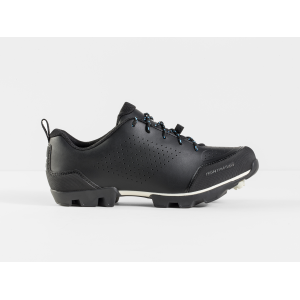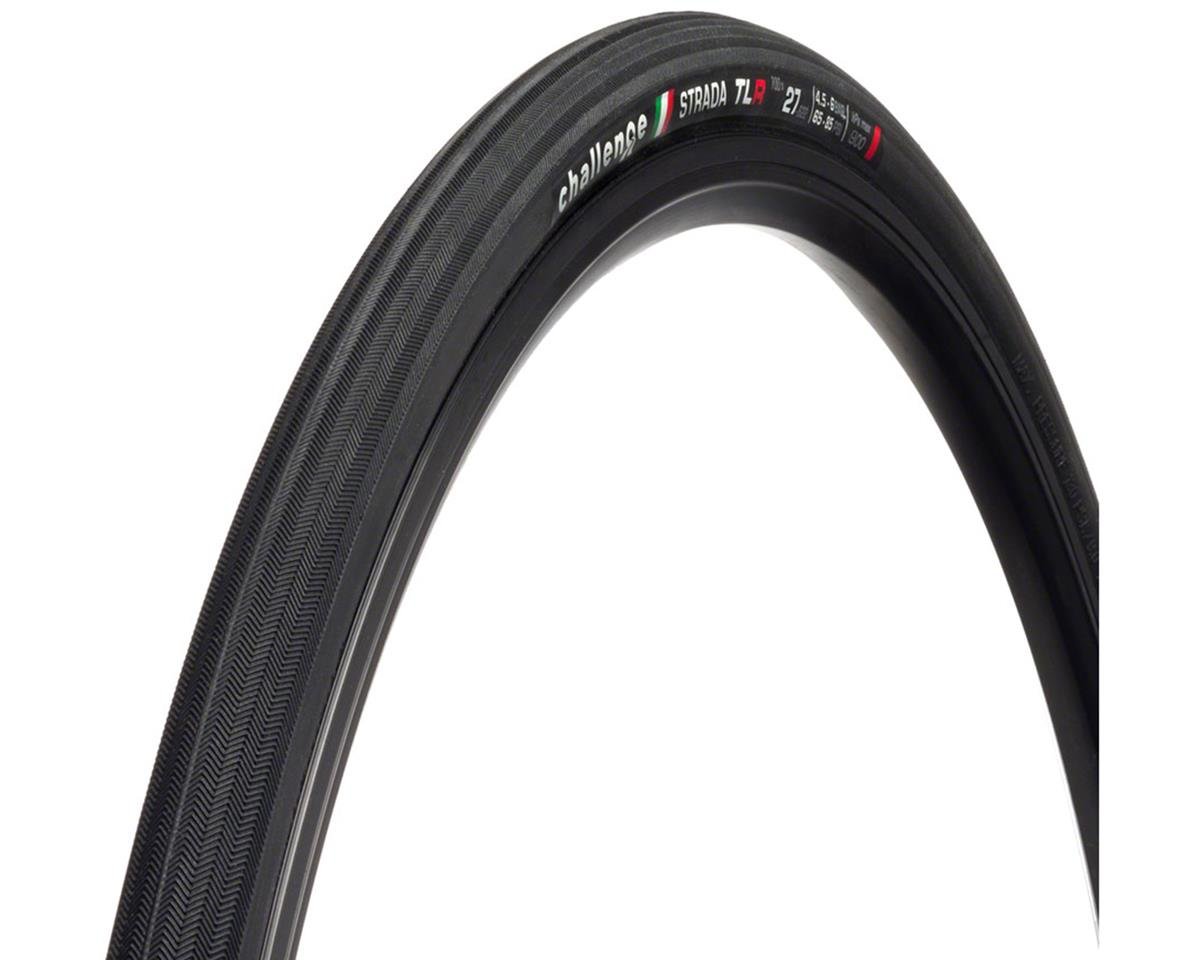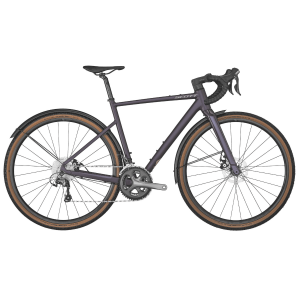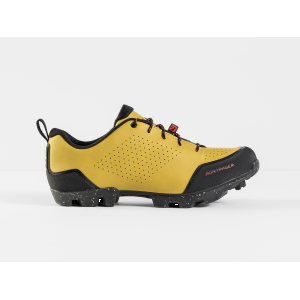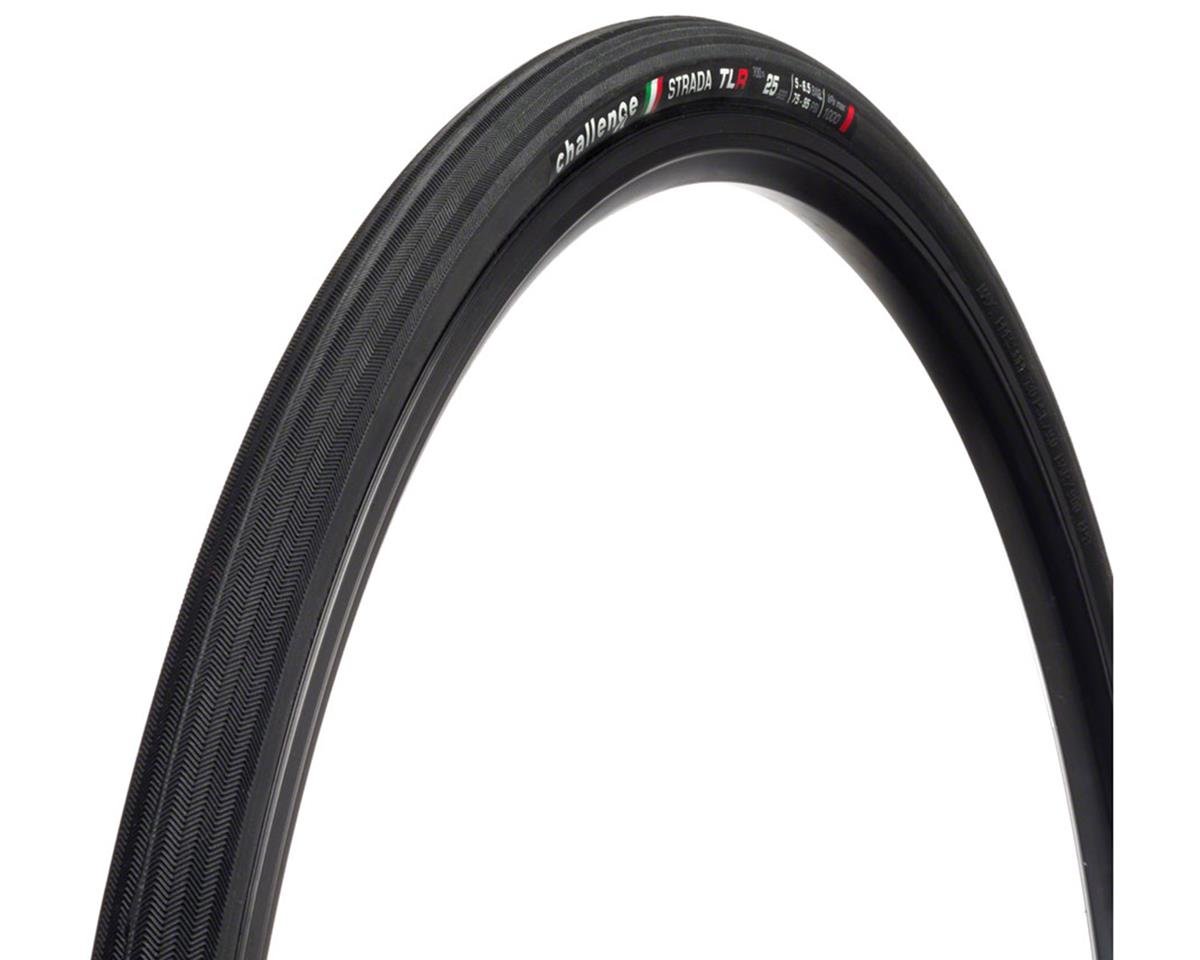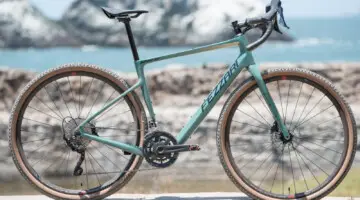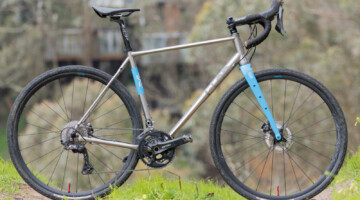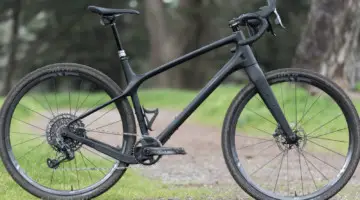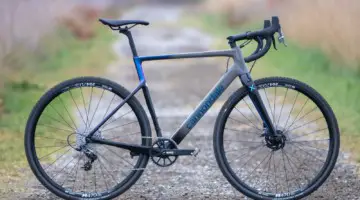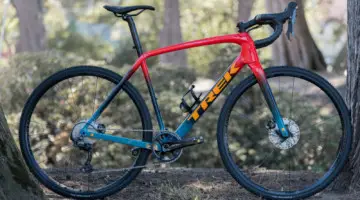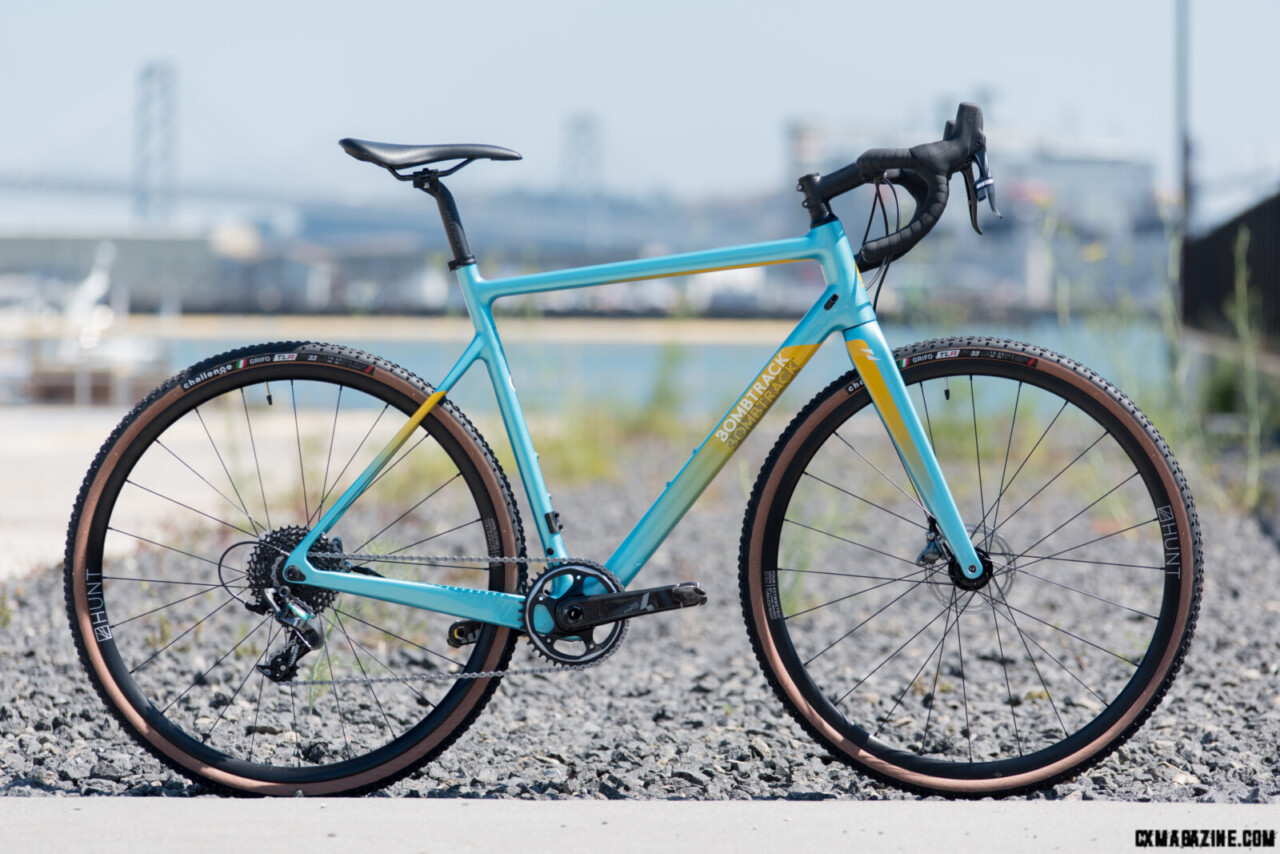
Bombtrack Tension C. © C.Lee/ Cyclocross Magazine
Cyclocross season is now upon us! Yet compared to five years ago, there are few dedicated cyclocross bikes in the United States, partly due to the high popularity of gravel cycling and the bikes being relatively similar. Gravel bikes evolved from cyclocross bikes to adapt to the needs of the long events. So while you can race cyclocross on a gravel bike, the cyclocross bike is a different steed. The true ‘cross machine is for the fast, sinewy courses with significantly varying terrain and conditions that define cyclocross. Last year we reviewed the Trek Boone 5, a dedicated cyclocross bike.
The Spirit of Cyclocross
Cyclocross is traditionally raced with road-type bikes and knobby road tires because its origin is off-season training for road racers in France, Belgium, and the Netherlands in the early 20th century. The conditions of the roads at the time and the use of shortcuts through farm fields made dismounting and running sometimes necessary. Mud buildup on the tires and around the frame necessitated space around the tires. Bicycles in the early 20th century already had a good amount of space around the wheels. As the road racing bike evolved when roads became smoother, the tire clearance shrank, and the cyclocross bike became a more specialized machine to keep the clearance around the wheels. Racers used their old road wheels, so the tires did not change that much. Perhaps a bit wider and with a knobby tread, but still the same size wheels and within the confines of the style of the old road racing bike.
Based on this history and tradition, cyclocross is racing a road-style bike on a short track that has a lot of off-road elements in any weather condition. In the modern era, mountain bike technology permeates cyclocross. Improvements in pedal, tire, and brake technology make racing safer and faster. So what differentiates short-track mountain biking from cyclocross? It’s the underbiking quality that creates the “Spirit of Cyclocross.”
Differentiation between mountain bike racing and cyclocross ultimately comes from regulatory bodies, whether it be the race promotor or a regional or world body. This is what enforces the “Spirit of Cyclocross,” and is why drop bars are required and tire size is limited at the top end of the sport. Thomas Frischknecht was the last to race flat bars at the UCI World Championships, until the UCI banned the flat bar completely.
The Spirit of Cyclocross is so much more than that. You can race whatever bike you want in most non-UCI, local cyclocross races in the U.S., which is a good thing to invite new racers to the sport. In other countries that may not be the case. However, in the end, does the bike define the sport? Some would say it does.
Bombtrack: What’s in a Name?
You may not have heard of the bicycle brand Bombtrack, especially if you live in North America. The small German company was started by pure BMXers in Cologne, Germany in 1996 with the BMX brands WethePeople and Radio Bikes. These brands have notoriety in the European BMX scene, freestyle, and racing. In 2011 the founders decided to move to “big wheel” bikes that they gravitated to as their lives wove into the bike messenger scene and away from BMX. Bombtrack’s first bikes were a fixed-wheel freestyle bike and a fixed-wheel track bike. The company derives its name from this start with “Bomb” and “Track” bikes, according to founder Manuel Shuerholtz. From there, cyclocross and mixed-terrain adventure continued the expansion.
Bombtrack came to the Sea Otter Classic in Monterey, California this spring to introduce themselves to the U.S. market with their new distributor HLC.
View this post on Instagram
Bombtrack now has a large portfolio of bikes including mountain, gravel and adventure bikes, as well as bikes for touring and commuting.
Bombtrack is one of the main sponsors of the NRW-Crosscup with 8 races across Germany. We love its support of local racing.
We are reviewing the Tension C top-end carbon cyclocross race bike, the same model raced by UCI Elite Gosse van der Meer. Bombtrack also has the Tension 1 and 2 aluminum cyclocross models to appeal to beginning and intermediate-level racers.
Bombtrack: What’s in a Frame?
The Bombtrack Tension C is a molded carbon frame with designs and specifications from Bombtrack to their long-time partner factory in Taiwan. The mold is not closed, so if you see another frame that has the same shape, it may or may not be the same engineering as the Bombtrack Tension C. “We specify layup, fibers and resin to our gusto – also when it comes to stiffness, lightness, comfort and such. A bit like as if you’d have a steel frame that could be either made from Hi-Ten or Reynolds,” according to Bombtrack’s founder Manuel Shuerholz. There is a mix of Toray T800 and T700 high-modulus fibers in the layup.
Our size L Tension C is classic European cyclocross geometry. The head tube angle is 72 degrees matched to a 73-degree seat tube. The bottom bracket drop is 64mm, a bit higher than the 7.0 that American cyclocross bikes adopted a decade ago. The 42.5cm chainstays and 60.1cm front center yield a short 101.8cm wheelbase. The effective top tube length for size L is 56.0cm giving a 382mm reach. The headtube is a nicely tall 160mm, contributing to the 584mm stack height, so you won’t need a lot of spacers under the stem.
Bombtrack’s all-carbon fork has a tapered steerer, 400mm axle-to-crown and a 45mm offset. The trail figure with a 33mm tire is 66mm, again classic cyclocross geometry, but 20mm less trail than the Fezarri Shafer adventure gravel bike I just reviewed. The brake hose runs internally through the left fork blade. The fork is standard for 12mm X 100mm through axle.
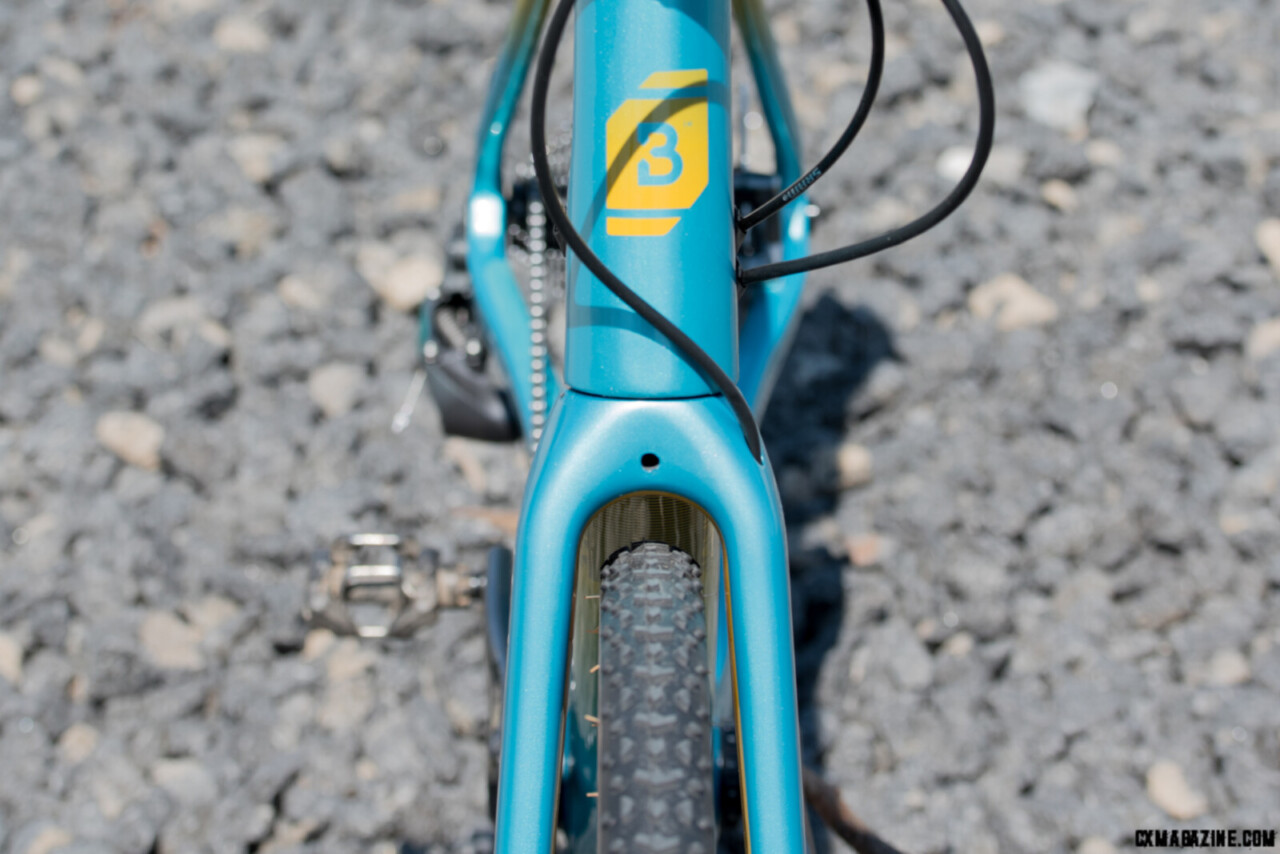
Tire clearance at the fork crown with a 34mm (measured) tire in place. © C.Lee/ Cyclocross Magazine
The Tension C has internal control line runs that enter into the downtube and run internally through the bottom bracket to exit at their destinations at the end of the chainstays. The rear derailleur cable runs naked through the frame from the downtube cable stop to its exit at the back of the right chainstay where there is another housing stop.
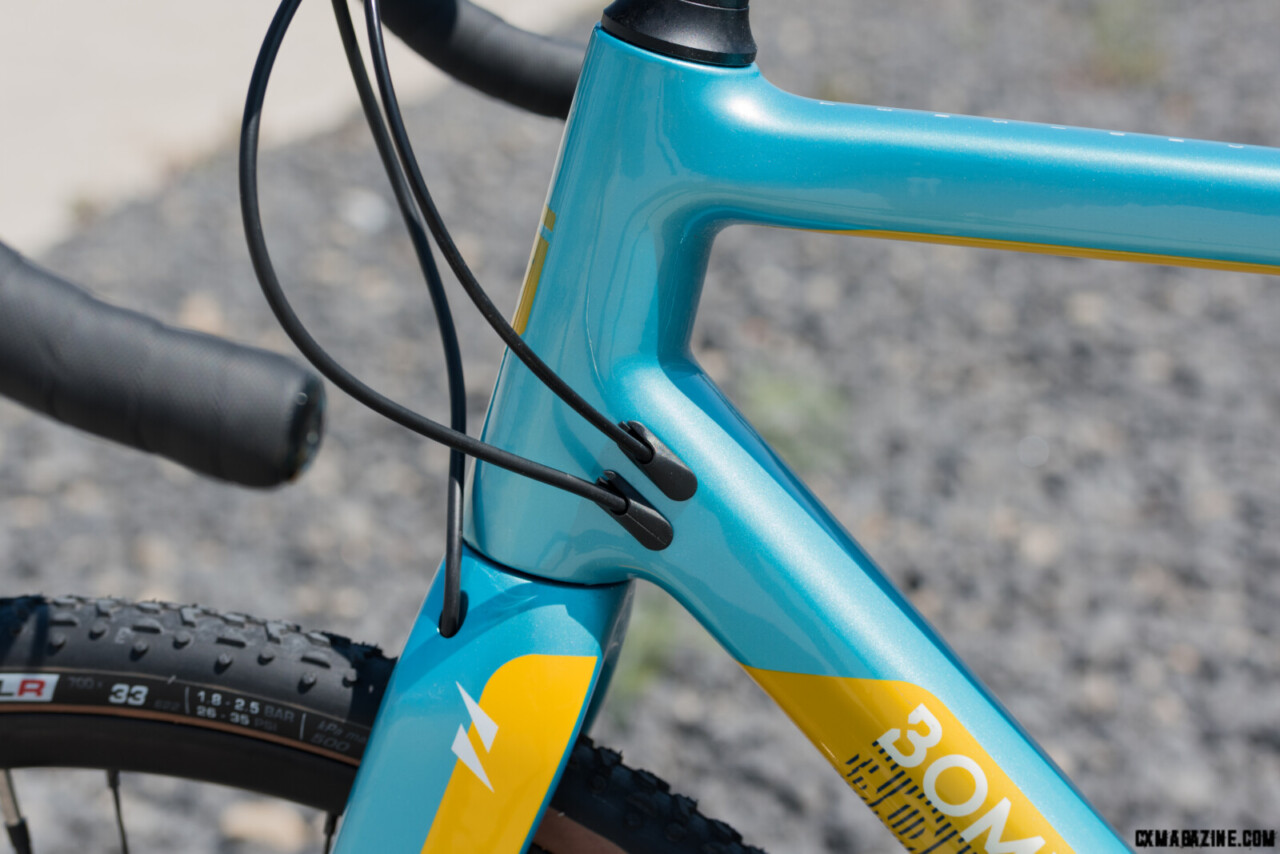
Standard internal control lines on the Bombtrack Tension C. © C.Lee/ Cyclocross Magazine
If you run a front derailleur, there is a housing stop on the other side of the downtube and an exit for the cable behind the bottom bracket. Alternatively, there are wire ports if you are running an electronic drivetrain and are not wireless. The rear end is 12mm X 142mm through axle and does not use the SRAM UDH. The bottom bracket is T47, 68mm wide.
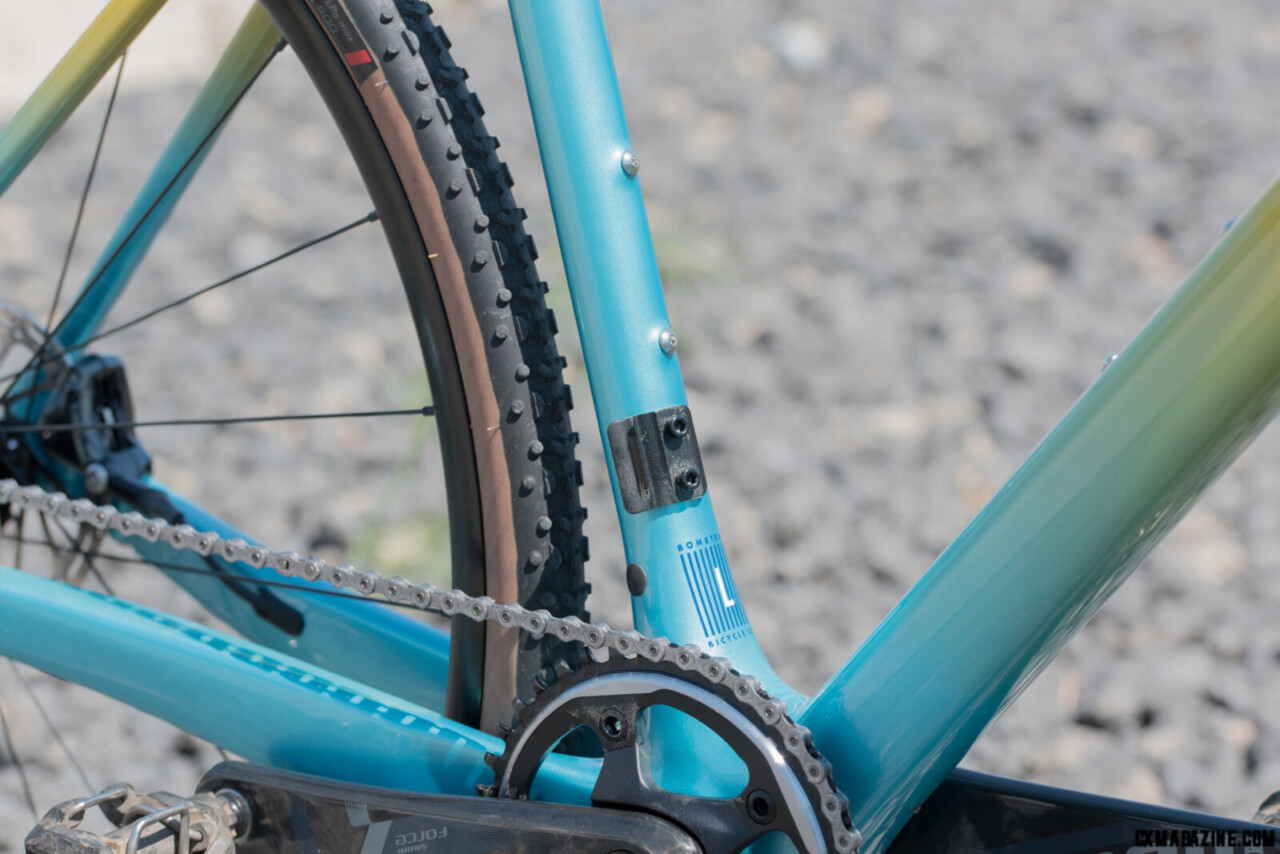
Provisions for a front derailleur, mechanical or electronic. Bombtrack Tension C. © C.Lee/ Cyclocross Magazine
The only mounting points on the frame are for two water bottles in the usual places of the down and seat tubes, but there is a fork crown piercing.
Significantly, the stated maximum tire clearance of the Bombtrack Tension C is 37mm. This is 1mm less than the Trek Boone, though I would argue it is nominally the same. You could probably fit the new 38mm Challenge cyclocross tires into the frame, but may not have a lot of mud clearance.
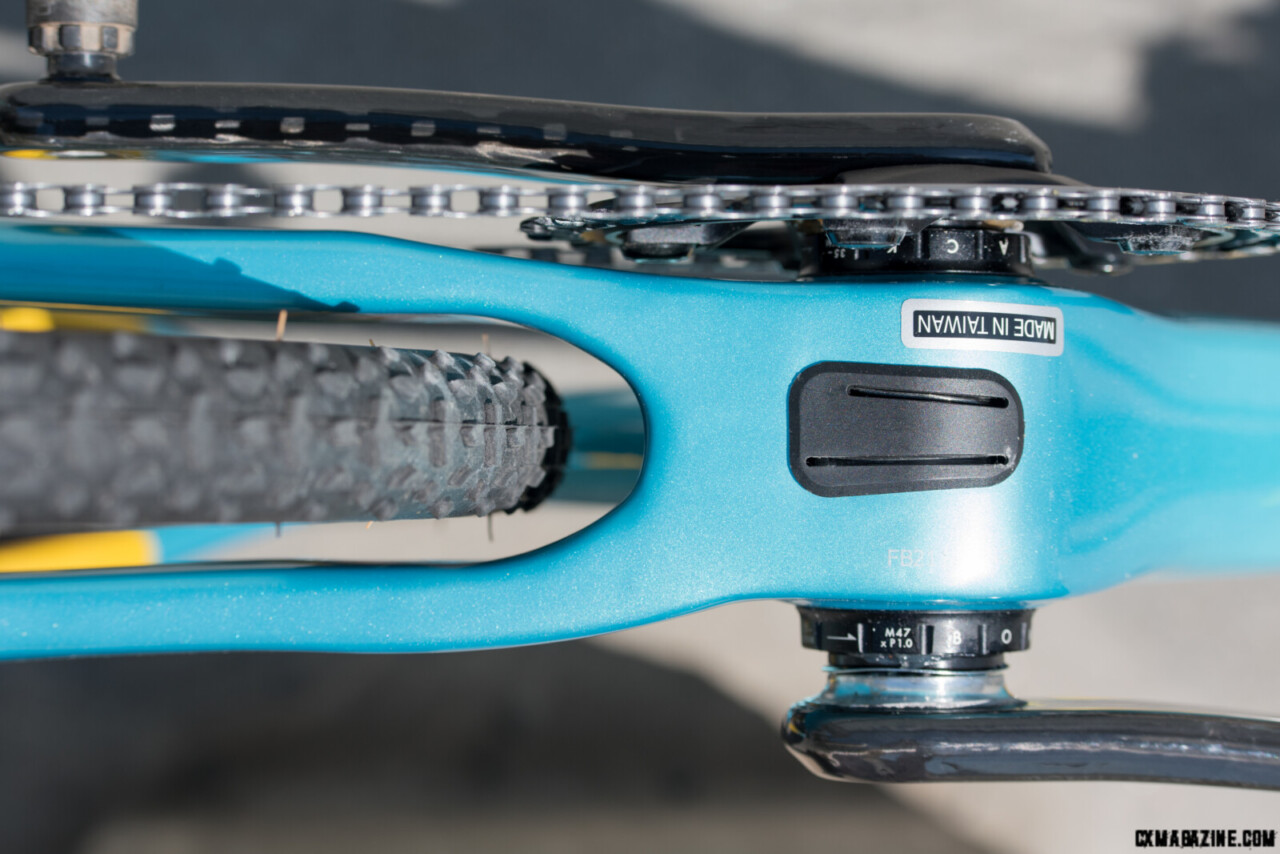
This is a 34mm tire in place on the Bombtrack Tension C. The Maximum specified is 37mm. © C.Lee/ Cyclocross Magazine
The Tension C we have is a beautiful turquoise with gold accents. The claimed frame weight is 1060 grams for a size S.
Bombtrack Tension C build
Our review sample Tension C is equipped with race-proven SRAM Force 1 and Ritchey components. Not so different than the bike Goss van der Meer races on.
SRAM Force 1 DoubleTap HRD hydraulic levers mechanically shift a SRAM Force 1 rear derailleur across the 11-speed 11-36 tooth SRAM 1130 cassette. The crank is a Force 1 FC-FRC-A-1 version with the 110mm BCD spider. A 40-tooth X-Sync wide-narrow chainring is standard on the Bombtrack Tension C. That gives a low gear of 30 gear inches, or a 1/1.11 ratio. The high gear is 98 gear inches or a 1/3.63 ratio. The outboard bottom bracket is supplied by Bombtrack for the 30mm SRAM crank spindle. SRAM Force flat-mount calipers clamp onto 140mm SRAM Centerline 6-bolt rotors.
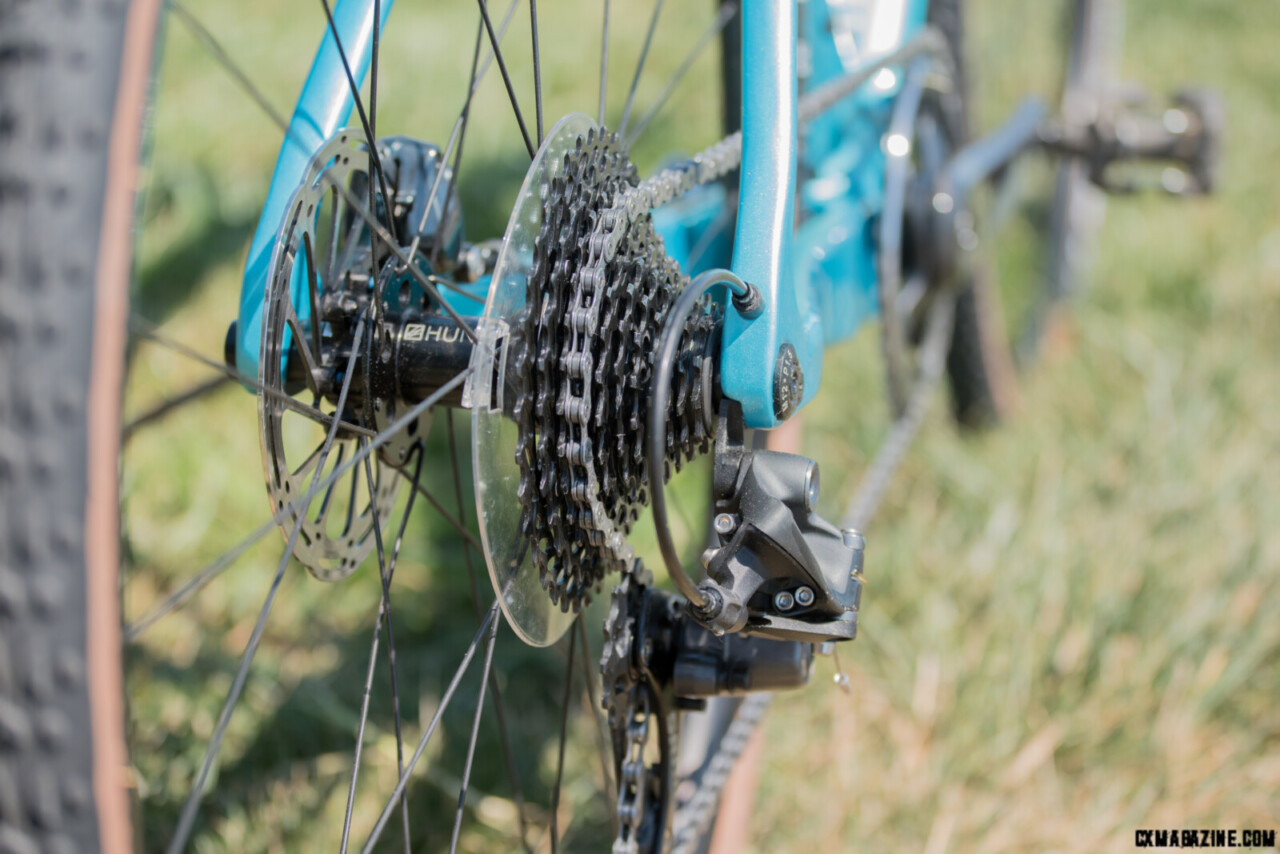
Clean cable routing on the Bombtrack Tension C. © C.Lee/ Cyclocross Magazine
Hunt 4 Season aluminum wheels are a choice for durability and cost. The wheelset weighs a claimed 1588 grams with an aluminum rim that is 19mm wide internally. The actual internal rim width is 19mm to the rim hook, and 21.5 if you measure under the hook to the rim wall. 24 X2 black stainless spokes hold the rim to Hunt’s own 6-bolt hubs. The rear hub is a 4-pawl ratchet with extra bearing seals compared to Hunt’s standard road hubs. The wheels come with a standard plastic rim strip, so you have to tape the rim to seal it for a tubeless setup.
Challenge 33mm Grifo TLR tan wall tires measure 34mm wide on the Hunt wheels. Tubes come installed with the bike, but this combination is an easy tubeless setup by simply removing the tubes, taping the rim, and adding valve stems and sealant.
The handlebar is an aluminum Ritchey Comp Skyline. This bar sweeps back about 5 degrees from the stem and flares 5 degrees from the hoods to the drops. It is paired to a Ritchey Comp aluminum 4-axis stem. Our size L tension C review sample has a 44cm wide bar and a 10cm long stem. The seatpost is a standard Ritchey Comp 2 bolt with a 27.2mm diameter. Bombtrack provides a self-branded saddle called the Dart.
All together, this bike weighs 18.5 pounds without pedals. Without the wheels, it is just a hair over 10.5 pounds! That’s quite light compared to most other test bikes.
Bomb the Track
It is quite refreshing to ride a sprightly cyclocross race bike after a summer of riding stable, steady gravel bikes, sometimes laden with provisions for long trail rides. The Bombtrack tension as we received it is ready to race even with the robust Hunt 4-season wheelset. I removed the tubes and easily went tubeless with the included Challenge TLR tires. Though marked 33mm the bead-to-bead measurement of this standard Challenge Grifo TLR is 94mm, so the actual tire measurement on the Hunt 4 Season rims is 34mm with the tires pumped up to 25 psi. If you need to meet a 33mm width restriction, this will not necessarily pass the caliper test, but the 33mm Team Edition Grifo will. I actually like the 1mm extra width and larger overall volume of this vulcanized Grifo TLR.
I first received the Bombtrack Tension C during the summer in California, so I took it on some of the same longer gravel rides and trails I usually do. We all used to ride our race bikes on these types of rides all year round, but with the advent of gravel bikes, handling these trails has changed. Going back to a race bike with narrower tires than I’ve recently become accustomed to takes some thought and adaptation.
The Bombtrack Tension steers quickly like a road bike, responding to a lean or flick of the bars. On a smooth road, this feels intuitive and fast on sweeping turns and through chicanes. Off-road, on a smooth cyclocross track like loam and grass, this feels great as long as your tires hold their grip. When the terrain gets bumpy, the Tension C reacts as I’d expect with a narrow tire low trail bike; the front wheel gets deflected by the imperfections and you have to adjust for that. It just takes a minor change of mindset and a bit of practice. This is exacerbated by roots and through ruts that may run more parallel to the track.
When riding through soft surfaces, such as sand, the front wheel will be pushed offline a bit easier than a bike with a slack front end. This is especially true with a narrower tire that sinks in, and because the race bike geometry balances with a bit more weight over the front wheel. All of that also makes descending that steep section of the trail require a bit more thought about your weight placement and brake control.
On the other hand, when riding up that steep section, it is easier to keep the bike on its line and easier to push over the lip of the ride up.
The Bombtrack Tension C damps vibration from rough surfaces and uneven tracks reasonably well. That’s in combination with the tires and tire pressure, but also inherent frame quality as well based on my experience. It’s not springy like a steel or titanium frame, but it is not bone-jarring at all. It feels lively when accelerating out of turns, up a climb, or in a sprint.
As cyclocross season begins, I’ve ridden the Tension C on shorter, faster rides with more cyclocross-type elements. I changed the wheels to a mid-weight carbon clincher set with the Challenge Handmade Team Edition TLC tires with the 320tpi cotton-polyester casing. As I mentioned, those are low-volume narrower tire that measures a true 33mm on a 19mm internal rim. Those tires are narrow by comparison to what I’ve ridden recently and definitely have a tubular-like ride and feel. That change, along with swapping the stock saddle for a carbon rail saddle, drops more than a pound of weight from the bike to yield a 17.0-pound bike (without pedals). With this setup, the bike is so spry, it leaps out from under you with each pedal stroke.
Weight loss is discounted over aerodynamics for road cycling nowadays, but in this case, it is remarkable when you pick up the bike and I think quite an advantage over the barriers and when running with the bike lap after lap. I think there is at least a psychological advantage when you have to accelerate out of every turn or if there is a long uphill section.
The higher bottom bracket is immediately noticeable when I swing a leg over, or when remounting after a barrier or run section. If this is your only bike, you will adapt to it, and depending on what you compare it to, it’s not that much at a centimeter or less. I’m not sure how much I might gain or lose from that bottom-bracket height difference. I rode up a steep ride-up and lightly hit my pedal 4 out of 6 laps. Better entering speed might avoid that, but if my bottom bracket was just a bit lower, a deeper pedal strike might have had deleterious consequences, and the same would be true when pedaling over roots or through an off-camber section.
On the other hand, I’ve always felt that a lower bottom bracket allows a bit more confidence through a tight turn, or when descending through a tight chicane or downhill switchback. It is certainly easier to remount if you struggle to smoothly remount when seeing blurry like I do!
Tension C Tire Clearance
37mm is enough clearance for a professional cyclocross race bike given regulations at the top end of the sport. Many races in Europe and the UK restrict even amateurs to a 33mm tire. The biggest market for Bombtrack is Europe, and the Tension C is a race cyclocross race bike. That said, American cyclocross is largely a grassroots participation sport and the restriction is only for the highest categories. Cyclocross courses in the Western U.S. often have rougher elements such as rocks and gravel. Challenge just introduced its handmade cyclocross tires with a 38mm width that I like. That tire fits in easily with ample clearance.
The tightest junction is at the chainstays behind the bottom bracket where the width is 51mm. I put a 42mm tire in without incident even if it does not follow the specifications or recommendations. I wouldn’t go larger and that makes the bike quite good for most off-cyclocross-season pursuits I might do. The larger tire increases trail, but only by a few mm, so it is really the larger tire volume that creates more steering confidence and rider comfort for me.
The reality is, many consumers will ride trails, enter a gravel race or two, and race cyclocross. It has sufficient tire clearance to do all that, but perhaps not enough if you live in an area that’s muddy year ’round or subscribe to the Dylan Johnson philosophy of wider-is-always-faster in gravel races.
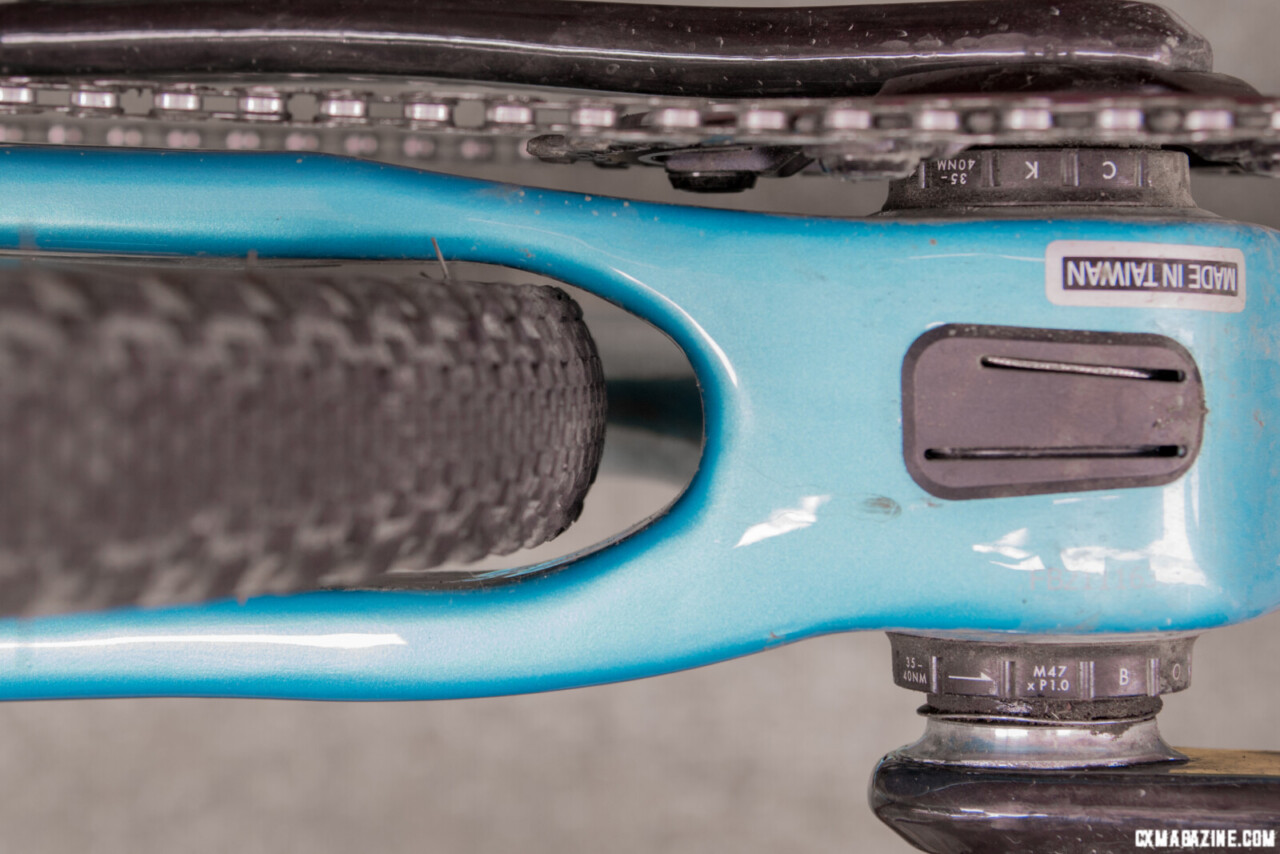
Bombtrack Tension C with a 42mm tire in place. © C.Lee/ Cyclocross Magazine
The SRAM Double-Tap mechanism is not my personal favorite, but it is fast-shifting and reliable. SRAM solved the pitfalls of the single-ring drivetrain, a setup that has been popular among American cyclocross racers. I’m glad Bombtrack included a cassette with a 36-tooth cog that allows almost 4 gear inches lower than the more standard 40X32 low, and slightly lower than the Trek Boone reviewed a year ago, so mere mortals can race the bike out of the box.
The Hunt 4-Season wheelset is a solid spec. It is easy to set up tubeless, and seems durable. I’ve had absolutely no issue with them except for the weight. A judicious choice of wheels setup tubeless saves a lot of weight. One of the lightest low-cost options I’ve ridden is the Lōgōs Epoche.
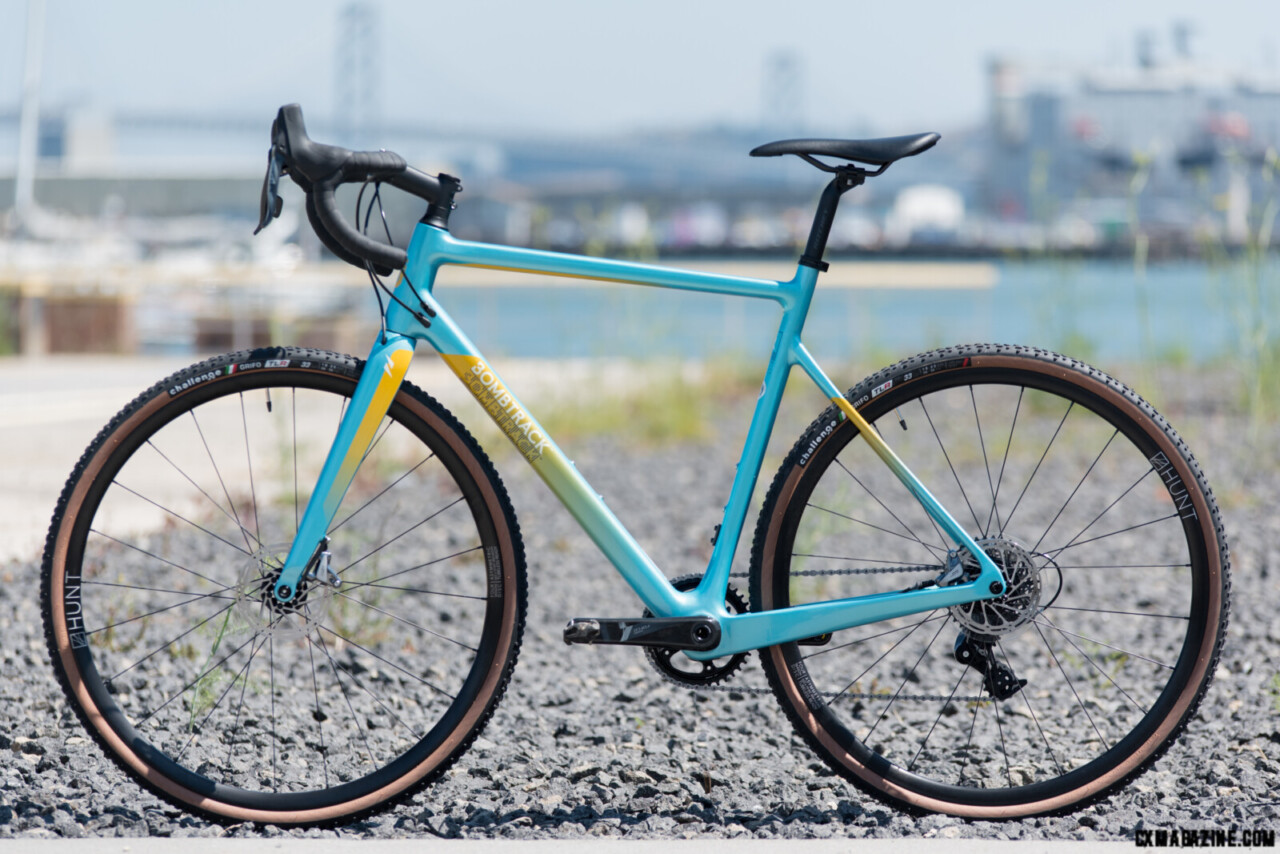
Bombtrack Tension C. © C.Lee/ Cyclocross Magazine
The Verdict
The Bombtrack Tension C is not an entry-level cyclocross bike. For $4250 USD, it is race-ready out of the box with a great starting weight and a spec that requires no upgrade. I would definitely set up the wheels tubeless. If you have extra cash and want to upgrade, a lighter wheelset is the first place to do so.
The Bombtrack Tension C competes directly with the GRX-equipped Trek Boone 6 with similar price, build, geometry, weight, gearing and tire clearance. Even the reported frame weights are similar. I think the Bombtrack Tension C is a great choice for a cyclocross race bike. The bike is light and nimble as a cyclocross race bike should be. It fits wide enough tires to be a great all-road, mixed-terrain bike in the cyclocross off-season. Remember we all used to use our ‘cross bikes year-round. Importantly, the tension C comes from a small company of riders who support ‘cross as a major sponsor of the German NRW-Crosscup.
Bombtrack has the aluminum Tension 1 and 2 with builds for entry and intermediate-level cyclocross racers respectively starting at USD 2500. If you want more tire clearance and calmer handling, Bombtrack has the Hook, available built from steel, carbon, or titanium. Every bike brand has a story behind it and with Bombtrack the story is of passion for cycling from a small German brand that loves the same things we do.
Bombtrack Tension C Specs
MSRP: USD 4250 as tested
Frame: Toray T700 and T800 hi-mod carbon monocoque 12 X 142mm through axle, 68mm T47 BB
Fork: All Carbon Disc, 45mm offset, 2 X 100 through axle
Weight: 18.5.0 pounds, as tested with no pedals; 13.0 lbs without wheels or pedals
Shifters: SRAM Force 1 double tap hydraulic 1 X 11-speed
Crankset: SRAM Force 1, 40T X-Sync
Brakes: SRAM Force flat mount calipers, SRAM rotors 140mm front and rear
Cockpit: Ritchey Comp 4-axis 10cm stem, Ritchey Comp Skyline 44cm aluminum handlebar, 5 deg backsweep
Seatpost: Ritchey Comp aluminum 2 bolt clamp, 27.2mm diameter
Saddle: Bombtrack Dart steel rails
Wheels: Hunt 4 season, 19mm inner width aluminum, 24 spokes
Tires: Challenge Grifo TLR 700C X 33mm
Warranty: Frame 3 years
Country of origin: Taiwan
More info: Bombtrack.com













